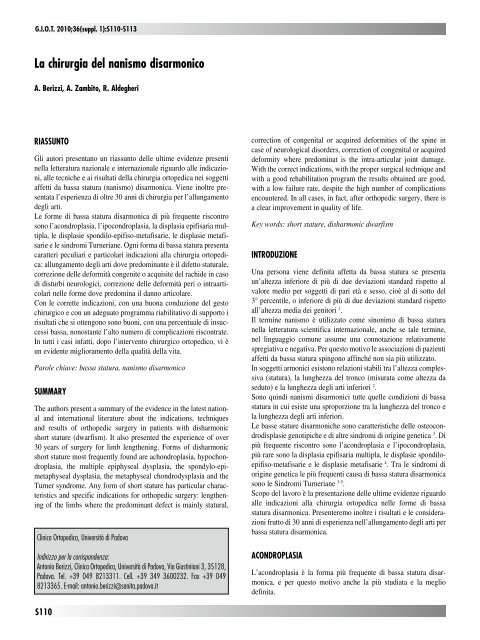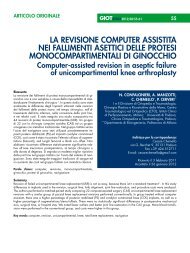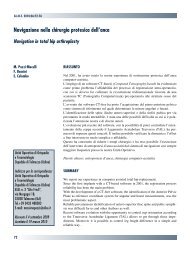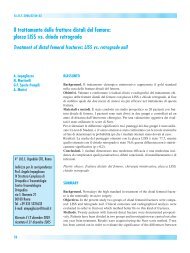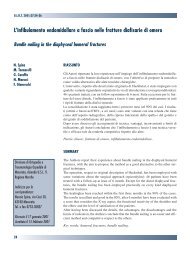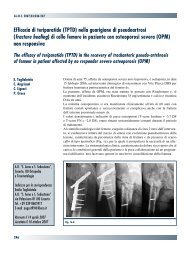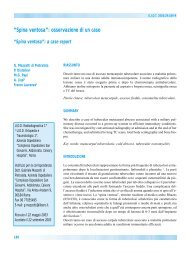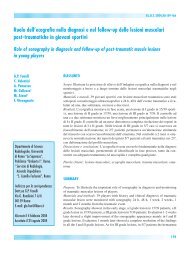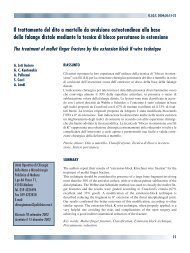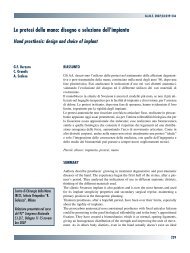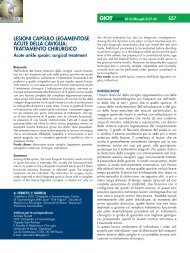30845 Suppl Giot.pdf - Giornale Italiano di Ortopedia e Traumatologia
30845 Suppl Giot.pdf - Giornale Italiano di Ortopedia e Traumatologia
30845 Suppl Giot.pdf - Giornale Italiano di Ortopedia e Traumatologia
You also want an ePaper? Increase the reach of your titles
YUMPU automatically turns print PDFs into web optimized ePapers that Google loves.
G.I.O.T. 2010;36(suppl. 1):S110-S113<br />
La chirurgia del nanismo <strong>di</strong>sarmonico<br />
a. Berizzi, a. zambito, r. aldegheri<br />
rIaSSuNTO<br />
Gli autori presentano un riassunto delle ultime evidenze presenti<br />
nella letteratura nazionale e internazionale riguardo alle in<strong>di</strong>cazioni,<br />
alle tecniche e ai risultati della chirurgia ortope<strong>di</strong>ca nei soggetti<br />
affetti da bassa statura (nanismo) <strong>di</strong>sarmonica. Viene inoltre presentata<br />
l’esperienza <strong>di</strong> oltre 30 anni <strong>di</strong> chirurgia per l’allungamento<br />
degli arti.<br />
Le forme <strong>di</strong> bassa statura <strong>di</strong>sarmonica <strong>di</strong> più frequente riscontro<br />
sono l’acondroplasia, l’ipocondroplasia, la <strong>di</strong>splasia epifisaria multipla,<br />
le <strong>di</strong>splasie spon<strong>di</strong>lo-epifiso-metafisarie, le <strong>di</strong>splasie metafisarie<br />
e le sindromi Turneriane. Ogni forma <strong>di</strong> bassa statura presenta<br />
caratteri peculiari e particolari in<strong>di</strong>cazioni alla chirurgia ortope<strong>di</strong>ca:<br />
allungamento degli arti dove predominante è il <strong>di</strong>fetto staturale,<br />
correzione delle deformità congenite o acquisite del rachide in caso<br />
<strong>di</strong> <strong>di</strong>sturbi neurologici, correzione delle deformità peri o intraarticolari<br />
nelle forme dove predomina il danno articolare.<br />
Con le corrette in<strong>di</strong>cazioni, con una buona conduzione del gesto<br />
chirurgico e con un adeguato programma riabilitativo <strong>di</strong> supporto i<br />
risultati che si ottengono sono buoni, con una percentuale <strong>di</strong> insuccessi<br />
bassa, nonostante l’alto numero <strong>di</strong> complicazioni riscontrate.<br />
In tutti i casi infatti, dopo l’intervento chirurgico ortope<strong>di</strong>co, vi è<br />
un evidente miglioramento della qualità della vita.<br />
Parole chiave: bassa statura, nanismo <strong>di</strong>sarmonico<br />
SuMMary<br />
The authors present a summary of the evidence in the latest national<br />
and international literature about the in<strong>di</strong>cations, techniques<br />
and results of orthope<strong>di</strong>c surgery in patients with <strong>di</strong>sharmonic<br />
short stature (dwarfism). It also presented the experience of over<br />
30 years of surgery for limb lengthening. Forms of <strong>di</strong>sharmonic<br />
short stature most frequently found are achondroplasia, hypochondroplasia,<br />
the multiple epiphyseal dysplasia, the spondylo-epimetaphyseal<br />
dysplasia, the metaphyseal chondrodysplasia and the<br />
Turner syndrome. Any form of short stature has particular characteristics<br />
and specific in<strong>di</strong>cations for orthope<strong>di</strong>c surgery: lengthening<br />
of the limbs where the predominant defect is mainly statural,<br />
Clinica Ortope<strong>di</strong>ca, Università <strong>di</strong> Padova<br />
In<strong>di</strong>rizzo per la corrispondenza:<br />
Antonio Berizzi, Clinica Ortope<strong>di</strong>ca, Università <strong>di</strong> Padova, Via Giustiniani 3, 35128,<br />
Padova. Tel. +39 049 8213311. Cell. +39 349 3600232. Fax +39 049<br />
8213365. E-mail: antonio.berizzi@sanita.padova.it<br />
S110<br />
correction of congenital or acquired deformities of the spine in<br />
case of neurological <strong>di</strong>sorders, correction of congenital or acquired<br />
deformity where predominat is the intra-articular joint damage.<br />
With the correct in<strong>di</strong>cations, with the proper surgical technique and<br />
with a good rehabilitation program the results obtained are good,<br />
with a low failure rate, despite the high number of complications<br />
encountered. In all cases, in fact, after orthope<strong>di</strong>c surgery, there is<br />
a clear improvement in quality of life.<br />
Key words: short stature, <strong>di</strong>sharmonic dwarfism<br />
INTrODuzIONE<br />
Una persona viene definita affetta da bassa statura se presenta<br />
un’altezza inferiore <strong>di</strong> più <strong>di</strong> due deviazioni standard rispetto al<br />
valore me<strong>di</strong>o per soggetti <strong>di</strong> pari età e sesso, cioè al <strong>di</strong> sotto del<br />
3° percentile, o inferiore <strong>di</strong> più <strong>di</strong> due deviazioni standard rispetto<br />
all’altezza me<strong>di</strong>a dei genitori 1 .<br />
Il termine nanismo è utilizzato come sinonimo <strong>di</strong> bassa statura<br />
nella letteratura scientifica internazionale, anche se tale termine,<br />
nel linguaggio comune assume una connotazione relativamente<br />
spregiativa e negativa. Per questo motivo le associazioni <strong>di</strong> pazienti<br />
affetti da bassa statura spingono affinché non sia più utilizzato.<br />
In soggetti armonici esistono relazioni stabili tra l’altezza complessiva<br />
(statura), la lunghezza del tronco (misurata come altezza da<br />
seduto) e la lunghezza degli arti inferiori 2 .<br />
Sono quin<strong>di</strong> nanismi <strong>di</strong>sarmonici tutte quelle con<strong>di</strong>zioni <strong>di</strong> bassa<br />
statura in cui esiste una sproporzione tra la lunghezza del tronco e<br />
la lunghezza degli arti inferiori.<br />
Le basse stature <strong>di</strong>sarmoniche sono caratteristiche delle osteocondro<strong>di</strong>splasie<br />
genotipiche e <strong>di</strong> altre sindromi <strong>di</strong> origine genetica 3 . Di<br />
più frequente riscontro sono l’acondroplasia e l’ipocondroplasia,<br />
più rare sono la <strong>di</strong>splasia epifisaria multipla, le <strong>di</strong>splasie spon<strong>di</strong>loepifiso-metafisarie<br />
e le <strong>di</strong>splasie metafisarie 4 . Tra le sindromi <strong>di</strong><br />
origine genetica le più frequenti causa <strong>di</strong> bassa statura <strong>di</strong>sarmonica<br />
sono le Sindromi Turneriane 3-5 .<br />
Scopo del lavoro è la presentazione delle ultime evidenze riguardo<br />
alle in<strong>di</strong>cazioni alla chirurgia ortope<strong>di</strong>ca nelle forme <strong>di</strong> bassa<br />
statura <strong>di</strong>sarmonica. Presenteremo inoltre i risultati e le considerazioni<br />
frutto <strong>di</strong> 30 anni <strong>di</strong> esperienza nell’allungamento degli arti per<br />
bassa statura <strong>di</strong>sarmonica.<br />
aCONDrOPLaSIa<br />
L’acondroplasia è la forma più frequente <strong>di</strong> bassa statura <strong>di</strong>sarmonica,<br />
e per questo motivo anche la più stu<strong>di</strong>ata e la meglio<br />
definita.


